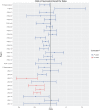Interictal epileptiform activity outside the seizure onset zone impacts cognition
- PMID: 28666338
- PMCID: PMC6167607
- DOI: 10.1093/brain/awx143
Interictal epileptiform activity outside the seizure onset zone impacts cognition
Abstract
See Kleen and Kirsch (doi:10.1093/awx178) for a scientific commentary on this article.Cognitive deficits are common among epilepsy patients. In these patients, interictal epileptiform discharges, also termed spikes, are seen routinely on electroencephalography and believed to be associated with transient cognitive impairments. In this study, we investigated the effect of spikes on memory encoding and retrieval, taking into account the spatial distribution of spikes in relation to the seizure onset zone as well as anatomical regions of the brain. Sixty-seven patients with medication refractory epilepsy undergoing continuous intracranial electroencephalography monitoring engaged in a delayed free recall task to test short-term memory. In this task, subjects were asked to memorize and recall lists of common nouns. We quantified the effect of each spike on the probability of successful recall using a generalized logistic mixed model. We found that in patients with left lateralized seizure onset zones, spikes outside the seizure onset zone impacted memory encoding, whereas those within the seizure onset zone did not. In addition, spikes in the left inferior temporal gyrus, middle temporal gyrus, superior temporal gyrus, and fusiform gyrus during memory encoding reduced odds of recall by as much as 15% per spike. Spikes also reduced the odds of word retrieval, an effect that was stronger with spikes outside of the seizure onset zone. These results suggest that seizure onset regions are dysfunctional at baseline, and support the idea that interictal spikes disrupt cognitive processes related to the underlying tissue.
Keywords: cognition; epileptiform discharges; interictal spikes; intracranial EEG; memory.
© The Author (2017). Published by Oxford University Press on behalf of the Guarantors of Brain. All rights reserved. For Permissions, please email: journals.permissions@oup.com.
Figures





Comment in
-
The nociferous influence of interictal discharges on memory.Brain. 2017 Aug 1;140(8):2072-2074. doi: 10.1093/brain/awx178. Brain. 2017. PMID: 28899025 Free PMC article.
-
Cognitive Problems in Epilepsy: Are Interictal Epileptiform Discharges to Blame?Epilepsy Curr. 2018 Jan-Feb;18(1):31-32. doi: 10.5698/1535-7597.18.1.31. Epilepsy Curr. 2018. PMID: 29844758 Free PMC article. No abstract available.
References
-
- Aarts JH, Binnie CD, Smit AM, Wilkins AJ. Selective cognitive impairment during focal and generalized epileptiform EEG activity. Brain 1984; 107 (Pt 1): 293–308. - PubMed
-
- Ahmad Z, Balsamo LM, Sachs BC, Xu B, Gaillard WD. Auditory comprehension of language in young children: neural networks identified with fMRI. Neurology 2003; 60: 1598–605. - PubMed
-
- Baxter MG. Involvement of medial temporal lobe structures in memory and perception. Neuron 2009; 61: 667–77. - PubMed
-
- Binnie CD. Cognitive impairment during epileptic form discharges: is it ever justifiable to treat the EEG? Lancet Neurol 2003; 2: 725–30. - PubMed
-
- Blake RV, Wroe SJ, Breen EK, McCarthy RA. Accelerated forgetting in patients with epilepsy: evidence for an impairment in memory consolidation. Brain 2000; 123: 472–83. - PubMed
MeSH terms
Grants and funding
LinkOut - more resources
Full Text Sources
Other Literature Sources
Medical

